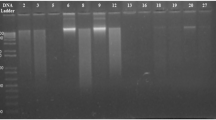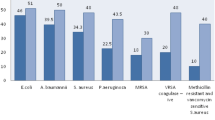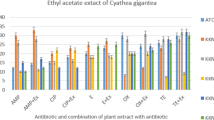Abstract
The resistance of hospital bacterial isolates against traditional germicides, which used frequently, is one of the important factors contributing to emerging nosocomial infections. Moreover, due to having the side effects of chemical substances, the development of novel low-risk natural compounds seems necessary for control the spread of resistant pathogens in hospital environments. The aim of this study was to compare the effect of carvacrol and glutaraldehyde against two common hospital acquired pathogens, including Pseudomonas aeruginosa and Staphylococcus aureus. In this study 365 samples were collected from different wards of hospitals of Khorramabad, Iran. One hundred and sixty samples were identified as P. aeruginosa and S. aureus by using standard microbiological methods. Then the antibacterial effects of four combinations including carvacrol+ethanol, carvacrol+dimethyl sulfoxide (DMSO), glutaraldehyde 2%, and pure glutaraldehyde (50%) were evaluated and determined using dilution broth and disk diffusion methods. Our results showed that the carvacrol had more antibacterial effects against selected bacteria compared to glutaraldehyde. Moreover, the optimal time and concentration of carvacrol+ethanol against hospital isolates of P. aeruginosa and S. aureus was determined after 1 h at concentration of 64 μl/ml and 8 μl/ml, respectively. In conclusion by comparing the results of carvacrol and glutaraldehyde, seem that carvacrol, as an herbal and natural agent, may be a suitable alternative to glutaraldehyde in hospital equipment’s’ sterilization.

Similar content being viewed by others
References
Sahlabadi F, Zandi H, Mokhtari M, Jamshidi S, Jasemizad T, Montazeri A, et al. The effectiveness evaluation of current disinfectants on pathogens isolated from surface of different parts of Shahid Sadughi accidents burns Hospital in City of Yazd. J Environ Health Eng. 2016;3(2):93–101.
Schabrun S, Chipchase L. Healthcare equipment as a source of nosocomial infection: a systematic review. J Hosp Infect. 2006;63(3):239–45.
Ducel G, Fabry J, Nicolle L. Prevention of hospital acquired infections: a practical guide. Prevention of hospital acquired infections: a practical guide. 2002(Ed. 2).
Oliveira PS, Souza SG, Campos GB, da Silva DC, Sousa DS, Araújo SP, et al. Isolation, pathogenicity and disinfection of Staphylococcus aureus carried by insects in two public hospitals of Vitória da Conquista, Bahia, Brazil. Braz J Infect Dis. 2014;18(2):129–36.
Hadadi A, RASOULINEZHAD M, Afhami S, Mohraz M. Epidemiological, clinical, Para clinical aspects of brucellosis in imam Khomeini and Sina Hospital of Tehran (1998–2005). 2006.
Hadizadeh M, Norouzi A, Taghadosi R, Mohebi S, Mohammadi M, Hasanzade A, et al. Prevalence of qnr, intI, and intII genes in extendedspectrum beta-lactamase (ESBL)-producing Escherichia coli isolated from clinical samples in Iran. Trop J Pharm Res. 2017;16(1):141–7.
Jarvis WR, Martone WJ. Predominant pathogens in hospital infections. J Antimicrob Chemother. 1992;29(suppl_A):19–24.
Al-Jubory SA, Naher HS, Saleh RH. A study of efficacy of disinfectants and bacterial contamination in Al-Hilla teaching hospital. Med J Babylon. 2012;9(4):890–900.
Sharma G, Rao S, Bansal A, Dang S, Gupta S, Gabrani R. Pseudomonas aeruginosa biofilm: potential therapeutic targets. Biologicals. 2014;42(1):1–7.
Manafi A, Kohanteb J, Mehrabani D, Japoni A, Amini M, Naghmachi M, et al. Active immunization using exotoxin a confers protection against Pseudomonas aeruginosa infection in a mouse burn model. BMC Microbiol. 2009;9(1):1–5.
Finck-Barbançon V, Goranson J, Zhu L, Sawa T, Wiener-Kronish JP, Fleiszig SM, et al. ExoU expression by Pseudomonas aeruginosa correlates with acute cytotoxicity and epithelial injury. Mol Microbiol. 1997;25(3):547–57.
Missiakas DM, Schneewind O. Growth and laboratory maintenance of Staphylococcus aureus. Curr Protoc Microbiol. 2013;28(1):9C. 1–9C. 1.9.
Control CD. Prevention. Outbreaks of community-associated methicillin-resistant Staphylococcus aureus skin infections--Los Angeles County, California, 2002–2003. MMWR Morb Mortal Wkly Rep. 2003;52(5):88.
Boucher HW, Corey GR. Epidemiology of methicillin-resistant Staphylococcus aureus. Clin Infect Dis. 2008;46(Supplement_5):S344–S9.
Rasigade J-P, Vandenesch F. Staphylococcus aureus: a pathogen with still unresolved issues. Infect Genet Evol. 2014;21:510–4.
Mihai MM, Holban AM, Giurcaneanu C, Popa LG, Buzea M, Filipov M, et al. Identification and phenotypic characterization of the most frequent bacterial etiologies in chronic skin ulcers. Rom J Morphol Embryol. 2014;55:1401–8.
Gebreyesus A, Gebre-Selassie S, Mihert A. Nasal and hand carriage rate of methicillin resistant Staphylococcus aureus (MRSA) among health care workers in Mekelle hospital, North Ethiopia. Ethiop Med J. 2013;51(1):41–7.
Khalafi T, Mohebbi SR, Moradi F, Khanipour F, Mahmoudian R, Montaseri M, et al. The trend of antibiotic resistance of Staphylococcus aureus isolated in clinical specimens in a referral hospital Shahid mohammadi hospital at Bandar abbas, south of Iran (2009-2014). Int Electron J Med. 2017;6(2):53–7.
Zschöck M, El-Sayed A, Eissa N, Lämmler C, Castañeda-Vazquez H. Resistencia a penicilina G y oxacilina, de cepas de Staphylococcus aureus aisladas de mastitis bovina subclínica. Vet Méx. 2011;42(3):207–17.
Velazquez-Meza ME, Hernández-Salgado M, Sánchez-Alemán MA. Evaluation of the antimicrobial activity of a super oxidized solution in clinical isolates. Microb Drug Resist. 2015;21(4):367–72.
Nostro A, Roccaro AS, Bisignano G, Marino A, Cannatelli MA, Pizzimenti FC, et al. Effects of oregano, carvacrol and thymol on Staphylococcus aureus and Staphylococcus epidermidis biofilms. J Med Microbiol. 2007;56(4):519–23.
Bagamboula C, Uyttendaele M, Debevere J. Inhibitory effect of thyme and basil essential oils, carvacrol, thymol, estragol, linalool and p-cymene towards Shigella sonnei and S. flexneri. Food Microbiol. 2004;21(1):33–42.
Liang WZ, Lu CH. Carvacrol-induced [Ca2+] i rise and apoptosis in human glioblastoma cells. Life Sci. 2012;90(17–18):703–11.
Arunasree K. Anti-proliferative effects of carvacrol on a human metastatic breast cancer cell line, MDA-MB 231. Phytomedicine. 2010;17(8–9):581–8.
Xu J, Zhou F, Ji BP, Pei RS, Xu N. The antibacterial mechanism of carvacrol and thymol against Escherichia coli. Lett Appl Microbiol. 2008;47(3):174–9.
Marinelli L, Di Stefano A, Cacciatore I. Carvacrol and its derivatives as antibacterial agents. Phytochem Rev. 2018;17(4):903–21.
Magi G, Marini E, Facinelli B. Antimicrobial activity of essential oils and carvacrol, and synergy of carvacrol and erythromycin, against clinical, erythromycin-resistant group a streptococci. Front Microbiol. 2015;6:165.
Kachur K, Suntres Z. The antibacterial properties of phenolic isomers, carvacrol and thymol. Crit Rev Food Sci Nutr. 2020;60(18):3042–53.
Memar MY, Raei P, Alizadeh N, Aghdam MA, Kafil HS. Carvacrol and thymol: strong antimicrobial agents against resistant isolates. Rev Med Microbiol. 2017;28(2):63–8.
Chavan PS, Tupe SG. Antifungal activity and mechanism of action of carvacrol and thymol against vineyard and wine spoilage yeasts. Food Control. 2014;46:115–20.
Nobrega RO, Teixeira APdC, Oliveira WAd, Lima EdO, Lima IO. Investigation of the antifungal activity of carvacrol against strains of Cryptococcus neoformans. Pharm Biol. 2016;54(11):2591–6.
Park J-H, Jeon Y-J, Lee C-H, Chung N, Lee H-S. Insecticidal toxicities of carvacrol and thymol derived from Thymus vulgaris Lin. against Pochazia shantungensis Chou & Lu., newly recorded pest. Sci Rep. 2017;7:40902.
Herruzo-Cabrera R, Uriarte M, Rey-Calero J. Antimicrobial effectiveness of 2% glutaraldehyde versus other disinfectants for hospital equipment, in an in vitro test based on germ-carriers with a high microbial contamination. Rev Stomatol Chir Maxillofac. 1999;100(6):299.
Henn SA, Boiano JM, Steege AL. Precautionary practices of healthcare workers who disinfect medical and dental devices using high-level disinfectants. Infect Control Hosp Epidemiol. 2015;36(2):180–5.
Liolios C, Gortzi O, Lalas S, Tsaknis J, Chinou I. Liposomal incorporation of carvacrol and thymol isolated from the essential oil of Origanum dictamnus L. and in vitro antimicrobial activity. Food Chem. 2009;112(1):77–83.
McGucken PV, Woodside W. Studies on the mode of action of glutaraldehyde on Escherichia coli. J Appl Bacteriol. 1973;36(3):419–26.
Pol IE, Krommer J, Smid EJ. Bioenergetic consequences of nisin combined with carvacrol towards Bacillus cereus. Innovative Food Sci Emerg Technol. 2002;3(1):55–61.
Ben Arfa A, Combes S, Preziosi-Belloy L, Gontard N, Chalier P. Antimicrobial activity of carvacrol related to its chemical structure. Lett Appl Microbiol. 2006;43(2):149–54.
Clinical, Institute LS. Performance standards for antimicrobial susceptibility testing. Wayne, PA: Clinical and Laboratory Standards Institute; 2017.
Bayer A, Kirby W, Sherris J, Turck M. Antibiotic susceptibility testing by a standardized single disc method. Am J Clin Pathol. 1966;45(4):493–6.
May J, Chan C, King A, Williams L, French G. Time–kill studies of tea tree oils on clinical isolates. J Antimicrob Chemother. 2000;45(5):639–43.
Saccucci M, Bruni E, Uccelletti D, Bregnocchi A, Sarto MS, Bossù M, et al. Surface disinfections: present and future. J Nanomater. 2018;2018:8950143.
Sharifi-Rad M, Varoni EM, Iriti M, Martorell M, Setzer WN, Del Mar CM, et al. Carvacrol and human health: a comprehensive review. Phytother Res. 2018;32(9):1675–87.
Quintas V, Prada-López I, Carreira MJ, Suárez-Quintanilla D, Balsa-Castro C, Tomás I. In Situ Antibacterial Activity of Essential Oils with and without Alcohol on Oral Biofilm: A Randomized Clinical Trial. Front Microbiol. 2017;8:2162.
Heinzel M. Phenomena of biocide resistance in microorganisms. Int Biodeterior Biodegradation. 1998;41(3):225–34.
Khan I, Bahuguna A, Kumar P, Bajpai VK, Kang SC. Antimicrobial potential of carvacrol against uropathogenic Escherichia coli via membrane disruption, depolarization, and reactive oxygen species generation. Front Microbiol. 2017;8(2421):1–9.
Acknowledgements
The authors would like to gratefully appreciate the Lorestan University of Medical Sciences and the khorramman pharmaceutical company, Khorramabad- Iran, for financially supporting this work under grant P/15/1190.
Author information
Authors and Affiliations
Corresponding authors
Ethics declarations
Conflict of interest
The authors have no conflict of interest to declare.
Additional information
Publisher’s note
Springer Nature remains neutral with regard to jurisdictional claims in published maps and institutional affiliations.
Rights and permissions
About this article
Cite this article
Hasanvand, T., Mohammadi, M., Abdollahpour, F. et al. A comparative study on antibacterial activity of carvacrol and glutaraldehyde on Pseudomonas aeruginosa and Staphylococcus aureus isolates: an in vitro study. J Environ Health Sci Engineer 19, 475–482 (2021). https://doi.org/10.1007/s40201-021-00620-1
Received:
Accepted:
Published:
Issue Date:
DOI: https://doi.org/10.1007/s40201-021-00620-1




